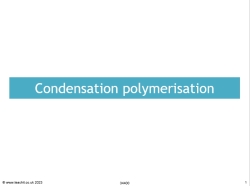Condensation polymerisation

This short PowerPoint provides a helpful outline for KS4 chemistry students of the key features of condensation reactions, with animated reaction equations to illustrate the process.
It's designed as a learning recap or revision activity, and is suitable for years 10 and 11 students for any GCSE Chemistry or organic chemistry specification, including AQA.
With a clear overview of the differences between addition polymerisation and condensation polymerisation, this lesson resource also includes an explanation of different monomers, functional groups, ester links and amino acid proteins. There are examples of displayed structure and structural formula and condensation polymers such as ethanol, ethane diol, propanoic acid, propanedioic acid and polyester.
The helpful animations of condensation polymerisation reactions to explain the process clearly to students.
Example definitions from the PowerPoint resource:
In addition polymerisation, one type of unsaturated monomer joins others of the same type, with no additional products.
In condensation polymerisation, the monomers have functional groups on each end.
The monomers are either of two types with the same functional group on each end OR of one type with a different group on each end.
